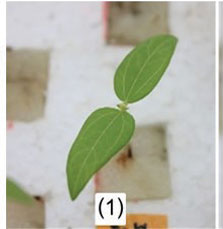กิจกรรมของเอนไซม์ต้านอนุมูลอิสระในรากและใบของถั่วเขียวในสภาวะเครียดเกลือ
คำสำคัญ:
ถั่ว, ความเครียดออสโมติก, อนุมูลอิสระออกซิเจนบทคัดย่อ
ดินเค็มส่งผลให้การเจริญเติบโตและผลผลิตของพืชลดลง การเข้าใจถึงกลไกการต้านทานความเค็มของพืช สามารถนำมาใช้เป็นข้อมูลสำหรับการปรับปรุงพันธุ์พืชต้านทานความเค็มได้ ซึ่งการแบ่งแยกส่วนของไอออน การปรับออสโมติก และการสร้างสารต้านอนุมูลอิสระ เป็นกลไกที่พบในพืชที่ต้านทานต่อสภาพเครียดจากความเค็ม งานวิจัยนี้จึงมีวัตถุประสงค์เพื่อคัดเลือกพันธุ์ถั่วเขียวที่ทนทานต่อสภาวะเครียดเกลือ ด้วยการประเมินอาการได้รับพิษด้วยสายตา วิเคราะห์ปริมาณโปรตีน และศึกษากิจกรรมเอนไซม์ต้านอนุมูลอิสระ ได้แก่ catalase (CAT), glutathione S-transferase (GST), guaiacol peroxidase (GPX) และ superoxide dismutase (SOD) ในรากและใบของถั่วเขียว 12 สายพันธุ์ และพันธุ์การค้า 2 พันธุ์ ที่ปลูกในสภาวะเครียดเกลือ NaCl ผลการทดลองพบว่า ถั่วเขียวสายพันธุ์ JP231216, JP240338, JP229175 และ JP240379 ที่สามารถทนทานต่อสภาวะเครียดเกลือที่ระดับความเข้มข้นของเกลือ 100 มิลลิโมลาร์ ได้ใกล้เคียงกับถั่วซอมบี้สายพันธุ์ TVNu240 และ AusTRCF322105 ทนทานต่อสภาวะเครียดเกลือ โดยมีปริมาณโปรตีนและกิจกรรมของเอนไซม์ต้านอนุมูลอิสระ ได้แก่ GPX และ SOD ในรากและใบเพิ่มขึ้น ดังนั้นสายพันธุ์ที่ทนทานนี้อาจนำไปใช้ประโยชน์เป็นแหล่งพันธุกรรมสำหรับปรับปรุงพันธุ์ถั่วเขียวให้ทนทานต่อสภาวะเครียดเกลือ
เอกสารอ้างอิง
ปราณี สีหบัณฑ์. 2558. เอกสารวิชาการ แนวทางการจัดทำระบบอนุรักษ์ดินและน้ำในพื้นที่ดินเค็ม. สำนักงานพัฒนาที่ดินเขต 5 กรมพัฒนาที่ดิน กระทรวงเกษตรและสหกรณ์.
สำนักงานเศรษฐกิจการเกษตร. 2559. สถิติการเกษตรของไทย ปีเพาะปลูก 2559. แหล่งข้อมูล: http://www.oae.go.th/download/download_journal/yearbook2559.pdf/ (20 สิงหาคม 2564).
AbdElgawad, H., G. Zinta, M.M. Hegab, R. Pandey, H. Asard and W. Abuelsoud. 2016. High salinity induces different oxidative stress and antioxidant responses in maize seedlings organs. Frontiers in Plant Science 7: 276, doi: 10.3389/fpls.2016.00276.
Abenavoli, M.R., D. Santis, C.M. Sidari, A. Sorgona, M. Badiani and G. Cacco. 2001. Influence of coumarin on the net nitrate uptake in durum wheat. New Phytologist 150(3): 619-627.
Alharby, H., H. Al-Zahrani, K.R. Hakeem, R. Rehman and M. Iqbal. 2019. Salinity-induced antioxidant enzyme system in mungbean (Vigma radiata (L.) Wilczek cv. genotypes. Pakistan Journal of Botany 51(4): 1-8.
Apel, K. and H. Hirt. 2004. Reactive oxygen species: metabolism, oxidative stress, and signal transduction. Annual Review of Plant Biology 55: 373-399.
Buono, D.D. and G. Ioli. 2011. Glutathione S-transferases of Italian ryegrass (Lolium multiflorum): activity toward some chemicals, safener modulation and persistence of atrazine and fluorodifen in the shoots. Journal of Agricultural and Food Chemistry 59(4): 1324-1329.
Bradford, M.M. 1976. A rapid and sensitive method for the quantitation of microgram quantities of protein utilizing the principle of protein-dye binding. Analytical Biochemistry 7(72): 248-254.
Cavalcanti, F.R., J.T.A. Oliveira, A.S. Martins-Miranda, R.A. Viégas and J.A.G. Silveira. 2004. Superoxide dismutase, catalase and peroxidase activities do not confer protection against oxidative damage in salt-stressed cowpea leaves. New Phytologist 163: 563-571.
Chawla, S., S. Jain and V. Jain. 2012. Salinity induced oxidative stress and antioxidant system in salt-tolerant and salt-sensitive cultivars of rice (Oryza sativa L.). Journal of Plant Biochemistry and Biotechnology 22(1): 27-34.
Cheng, Y., G. Chen, D. Hao, H. Lu, M. Shi, Y. Mao, X. Huang, Z. Zhang and L. Xue. 2014. Salt-induced root protein profile change in seedling of maize inbred lines with differing salt tolerances. Chilen Journal of Agricultural Research 74(4): 468-476.
Dachapak, S., P. Somta, K. Naito, N. Tomooka, A. Kaga and P. Srinives. 2019. Detection of quantitative trait loci for salt tolerance in zombie pea [Vigna vexillata (L.) A. Rich]. Euphytica 215: 208.
Dietz, K.J., I. Turkan and A. Krieger-Liszkay. 2016. Redox- and reactive oxygen species-dependent signaling into and out of the photosynthesizing chloroplast. Plant Physiology 171(3): 1541-1550.
Giannopolitis, C.N. and S.K. Ries. 1977. Superoxide dismutase: I. occurrence in higher plants. Plant Physiology 59(2): 309-314.
Havir, E.A. and N.A. McHale. 1987. Biochemical and developmental characterization of multiple forms of catalase in tobacco leaves. Plant Physiology 84(2): 450-455.
Huang, L., L.J. Yu, X. Zhang, B. Fan, F.Z. Wang, Y.S. Dai, H. Qi, Y. Zhou, L.J. Xie and S. Xiao. 2019. Autophagy regulates glucose-mediated root meristem activity by modulating ROS production in Arabidopsis. Autophagy 15(3): 407-422.
Huang, S., O. Van Aken, M. Schwarzlander, K. Belt and A.H. Millar. 2016. The roles of mitochondrial reactive oxygen species in cellular signaling and stress response in plants. Plant Physiology 171(3): 1551-1559.
James, J.A., C. Blake, C.S. Byrt and R. Munns. 2011. Major genes for Na+ exclusion, Nax1 and Nax2 (wheat HKT1;4 and HKT1;5), decrease Na+ accumulation in bread wheat leaves under saline and waterlogged conditions. Journal of Experimental Botany 62: 2939-2947.
Jebara, S., M. Jebara, F. Limam and M.E. Aouani. 2005. Changes in ascorbate peroxidase, catalase, guaiacol peroxidase and superoxide dismutase activities in common bean (Phaseolus vulgaris) nodules under salt stress. Journal of Plant Physiology 162(8): 929-936.
Jiang, Z., B. Ma, K.O. Erinle, B. Cao, X. Liu, S. Ye and Y. Zhang. 2016. Enzymatic antioxidant defense in resistant plant: Pennisetum americanum (L.) K. Schum during long-term atrazine exposure. Pesticide Biochemistry and Physiology 133: 59-66.
Kumar, S. and G. Pandey. 2020. Biofortification of pulses and legumes to enhance nutrition. Heliyon 6(3): e03682.
Nair, R.M., R.Y. Yang, W.J. Easdown, D. Thavarajah, P. Thavarajah, J.A. Hughes and J.D.H. Keatinge. 2013. Biofortification of mungbean (Vigna radiata) as a whole food to enhance human health. Journal of the Science of Food and Agriculture 93(8): 1805-1813.
Parvaiz, A. and S. Satyawati. 2008. Salt stress and phyto-biochemical responses of plants-a review. Plant Soil Environment 54(3) 89-99.
Remme, R.N., N.A. Ivy, M.A.K. Mian and M. Rohman. 2013. Effect of salinity stress on glutathione-S-transferase (GSTs) of maize. Journal of Agriculture and Veterinary Science 4(4): 42-52.
Sandalio, L.M. and M.C. Romero-Puertas. 2015. Peroxisomes sense and respond to environmental cues by regulating ROS and RNS signaling networks. Annals of Botany 116(4): 475-485.
Sanoubar, R., A. Cellini, G. Gianfranco and F. Spinelli. 2020. Osmoprotectants and antioxidative enzymes as screening tools for salinity tolerance in radish (Raphanus sativus). Horticultural Plant Journal 6(1): 14-24.
Sarker, U. and S. Oba. 2020. The response of salinity stress-induced A. tricolor to growth, anatomy, physiology, non-enzymatic and enzymatic antioxidants. Frontiers in Plant Science 11: 559876, doi: 10.3389/fpls.2020.559876.
Tester, M. and R. Davenport. 2003. Na+ Tolerance and Na+ transport in higher plants. Annals of Botany 92: 503-527.
Uarrota, V.G., R. Moresco, E.C. Schmidt, Z.L. Bouzon, E.C. Nunes, E.O. Neubert, L.A.M. Peruch, M. Rocha and M. Maraschin. 2016. The role of ascorbate peroxidase, guaiacol peroxidase, and polysaccharides in cassava (Manihot esculenta Crantz) roots under postharvest physiological deterioration. Food Chemistry 197: 737-746.






